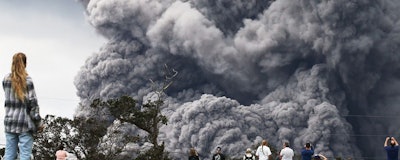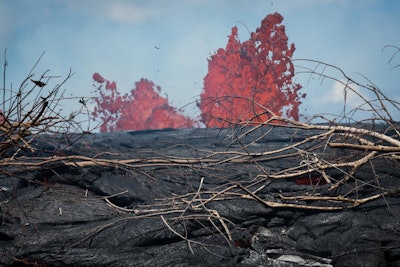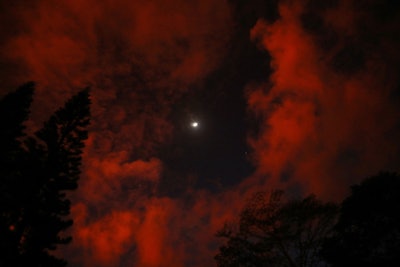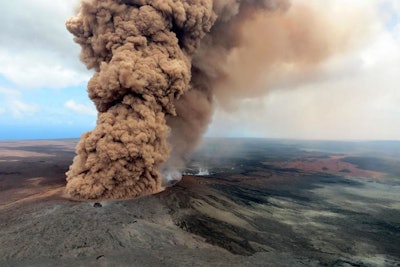
Hawaii’s Kilauea volcano eruption causes chemical threats to the residents of Big Island, including acid rain, volcanic smog, and a toxic lava-haze.
The eruption of the Big Island volcano on May 3, 2018, caused cracks in the ground, releasing slow-moving molten lava and toxic sulfur dioxide gas into surrounding communities.
Sulfur dioxide is a colorless, irritating gas that has an acrid odor like fireworks or a burning match. When sulfur dioxide is released into the air and rises high into the atmosphere, it can mix and react with water, oxygen, and other chemicals to form more acidic pollutants, known as acid rain.
Acid rain contaminates drinking water and can impair visibility through the air. If there is a lot of sulfur blown consistently in the same direction, it has the ability to kill plants and cause respiratory failure in people, as well as etch eyeglasses or car windows, according to Tracy Gregg, an associate professor of geology at the University of Buffalo.
When sulfur dioxide enters the stratosphere, it can also have a cooling effect on the Earth’s surface. The gas causes chemical reactions and reflects the infrared radiation from space that normally warms the Earth, and this can have a cooling effect on the Earth’s surface. Chemical reactions in the atmosphere caused by the eruptions can contribute to the depletion of the ozone—which helps block harmful ultraviolet radiation.
“It has overall a cooling of the surface of the Earth but a warming of the lower stratosphere,” said Valentina Aquila, assistant professor in the Department of Environmental Science at American University.
Recently, the rate of sulfur dioxide gas shooting from the ground fissures tripled, causing Hawaii County to repeat air quality warnings. At the volcano’s summit, two explosive eruptions unleased clouds of ash, which have blown primarily from the east, spreading the foul air as far as 60 miles across the southern part of the island.
It's the larger, heavier particles—like ash—from a volcanic eruption that cause more problems in the vicinity of the actual volcano. People on the ground and near the volcano truly will be affected by the falling ash, gases in the air, lava, and possible acid rain.
 Fissure 21 of the Kilauea volcano erupts in the Leilani Estates subdivision of Pahoa, Hawaii, on May 22. The gases released after a volcanic eruption can enter the upper atmosphere and sometimes cause the cooling of the Earth. (Ronit Fahl/Getty Images)
Fissure 21 of the Kilauea volcano erupts in the Leilani Estates subdivision of Pahoa, Hawaii, on May 22. The gases released after a volcanic eruption can enter the upper atmosphere and sometimes cause the cooling of the Earth. (Ronit Fahl/Getty Images)The sulfur dioxide gas emitted from the volcano can also react with oxygen and moisture in the atmosphere to create vog—volcanic smog.
Within hours to days, these sulfur dioxide reactions convert to fine particles which scatter sunlight, causing visible haze that can be observed downwind of Kilauea. Areas to the west side of the Hawaiian island are mostly affected by the fine particles; however, areas closer to the eruptive vents, including the communities ranging from Ocean View to Hilo, can be exposed to both sulfur dioxide gas and fine particles during periods of vog.
Vog can cause rusting to metal objects such as cars, industrial and farm equipment, and building components, according to the U.S. Geological Survey (USGS). Additionally, it can damage plants and cause severe chemical burns in less than one day. In the past, farmers on the island of Hawaii have lost crops in greenhouses because vog can enter the structures through air vents.
Vog also can cause health problems, especially for the elderly and infants and those suffering from respiratory conditions and cardiovascular disease. Adverse effects of vog include headaches, difficulty breathing, watery eyes, and sore throat.
 The moon is seen behind clouds glowing orange-red above a lava flow from a Kilauea volcano fissure on Hawaii's Big Island on May 19, 2018 in Kapoho, Hawaii. The U.S. Geological Survey said the volcano erupted explosively on May 17 launching a plume about 30,000 feet into the sky. (Photo by Mario Tama/Getty Images)
The moon is seen behind clouds glowing orange-red above a lava flow from a Kilauea volcano fissure on Hawaii's Big Island on May 19, 2018 in Kapoho, Hawaii. The U.S. Geological Survey said the volcano erupted explosively on May 17 launching a plume about 30,000 feet into the sky. (Photo by Mario Tama/Getty Images)Along with acid rain and vog, Hawaiian residents near Kilauea are being confronted with a new threat: laze, a toxic cloud mashup of lava and haze.
Laze forms when hot, 2,000-degree lava hits the cool sea water. This connection forms a hydrochloric acid steam cloud that billows into the air, along with fine particles of glass.
Most important to the creation of laze, the USGS writes, is the creation of magnesium salts. These “react with steam to form hydrogen chloride gas.” When that gas mixes with water, it forms hydrochloric acid, which, true to its name, is acidic, and very strongly so.
According to scientists, the acid in the plume is about as corrosive as diluted battery acid. Laze can cause irritations of the skin, eyes, and lungs. Those suffering from asthma or emphysema may be more vulnerable to its effects.
The glass released into the air is in the form of fine glass shards. Getting hit by it might feel like being sprinkled with glitter.
Laze has been a deadly threat in the past. "This hot, corrosive gas mixture caused two deaths immediately adjacent to the coastal entry point in 2000 when seawater washed across recent and active lava flows," the Hawaii Volcano Observatory said.
Kilauea, in the southeastern part of the Big Island, is one of the most active volcanoes in the world, and it has been erupting on and off for hundreds of thousands of years. It is classified as a shield volcano—meaning it is broad and domed with sloping sides made up of runny, fluid lava that doesn’t explode.
Kilauea has been erupting continuously since 1983 with only occasional spans of quiet activity. Typical gas emission rates measured for Kilauea have ranged from 8,000 to more than 20,000 metric tons per day of CO2 and hundreds to more than 10,000 metric tons per day of SO2.
Since its most recent eruption on May 3, 2018, the volcano has opened more than 20 vents, including four that have merged into one large crack. It has been gushing lava high into the sky and sending a river of molten rock toward the ocean at about 300 yards per hour.
Kilauea has burned about 40 structures, including two dozen homes, since the eruption began. Nearly 3,000 earthquakes have also been recorded over the past month.
Yet, even with more than 2,000 residents under evacuation, life largely goes on as normal on much of the Big Island. The tourism industry is still in full swing, and the island's airports remain open.
In recent days, the lava began to move more quickly and emerge from the ground in greater volume. Scientists said that’s because the lava that first erupted was magma left over from a 1955 eruption that had been stored in the ground for the past six decades. The molten rock that began emerging over the past few days was from magma that has recently moved down the volcano’s eastern flank from one or two craters that sit further upslope—the Puu Oo crater and the summit crater.
Even though Kilauea is emitting lots of carbon dioxide, it won’t worsen global warming to any meaningful degree, according to Maarten de Moor, a volcanologist.
“Volcanic output of greenhouse gases is roughly matched by ocean and terrestrial carbon uptake,” said climatologist Michael Mann, the director of the Earth System Science Center at Penn State. “So unless there is a dramatic upsurge in volcanic activity, it doesn’t contribute at all—the background rate of volcanic outgassing is already nearly balanced out by natural carbon uptake. The imbalance is so small that it has to add up over millions of years to amount to anything significant.”
There is one other powerful greenhouse gas being caused by Kilauea, as its lava burns through organic matter: methane. But that’s “a really local effect,” de Moor said. “It’s not going to have any big impact on anything global.”
Scientists do not know how long this eruption episode will last. Authorities on Sunday warned the public to stay away from the toxic steam cloud.
The Coast Guard said it was enforcing a safety zone extending 1000 feet around the ocean entry point. Gov. David Ige told reporters in Hilo that the state was monitoring the volcano and keeping people safe.
 Hawaii’s Kilauea volcano erupted last week, sending molten lava and toxic gas into the surrounding communities (U.S. Geological Survey via Getty Images)
Hawaii’s Kilauea volcano erupted last week, sending molten lava and toxic gas into the surrounding communities (U.S. Geological Survey via Getty Images)





















